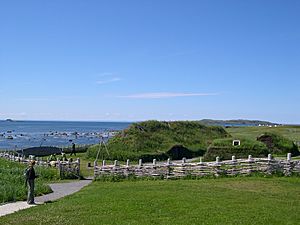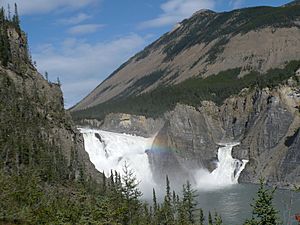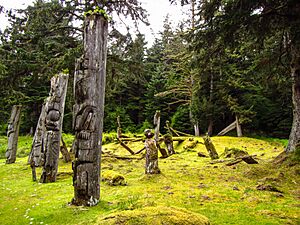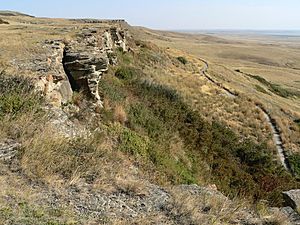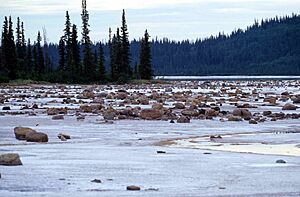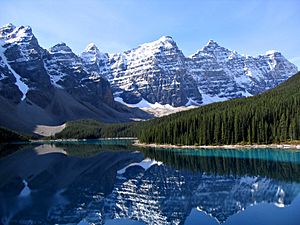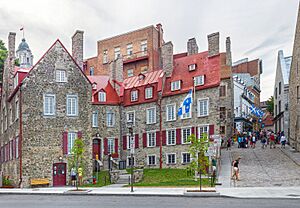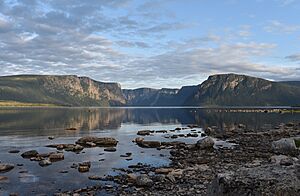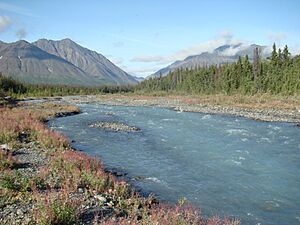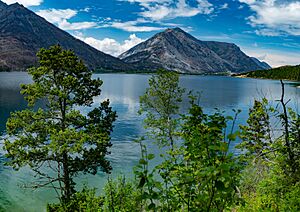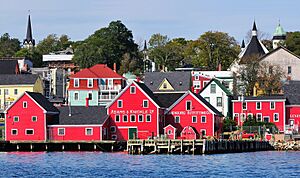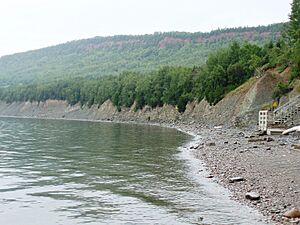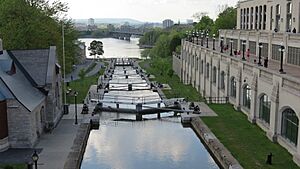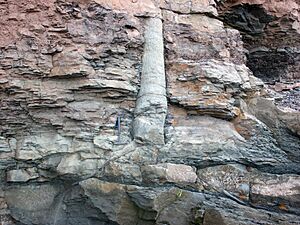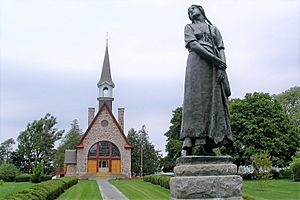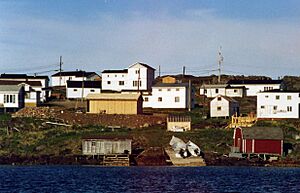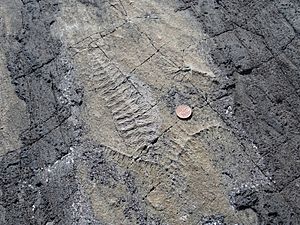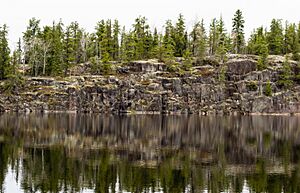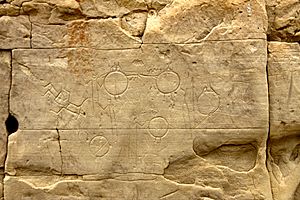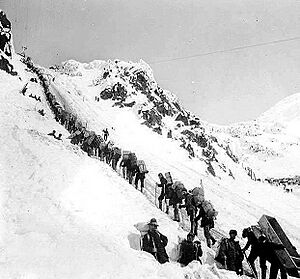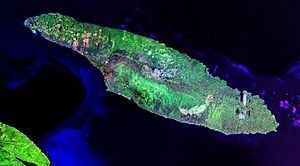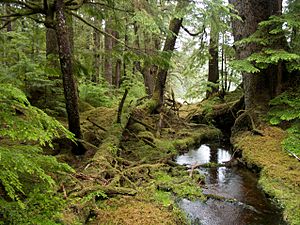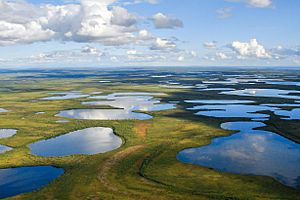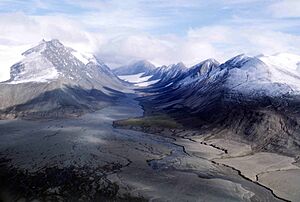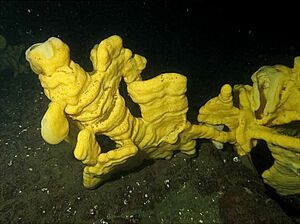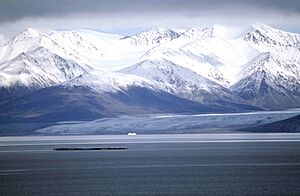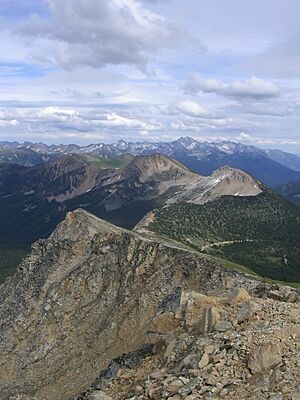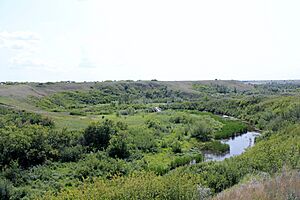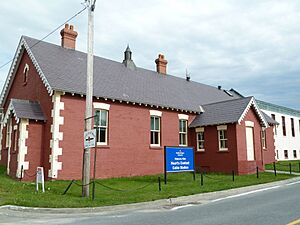List of World Heritage Sites in Canada facts for kids
Canada is home to many amazing places that are recognized by UNESCO, a special group from the United Nations. These places are called World Heritage Sites because they are super important for their culture or natural heritage. Cultural sites can be old buildings, monuments, or places where people lived long ago. Natural sites are beautiful natural areas, special rock formations, or places where rare plants and animals live.
Canada agreed to protect these special places on July 23, 1976. Today, Canada has 22 World Heritage Sites, and 10 more are on a "tentative list," meaning they might be added in the future.
The first two Canadian sites added to the list were L'Anse aux Meadows and Nahanni National Park Reserve in 1978. The newest sites, Tr’ondëk-Klondike and Anticosti, were added in 2023. Two of Canada's sites are shared with the United States. Ten sites are important for their culture, eleven for their nature, and one, Pimachiowin Aki, is special for both!
Canada's World Heritage Sites
UNESCO chooses sites based on ten different rules. Each site must meet at least one of these rules. Rules 1 to 6 are for cultural sites, and rules 7 to 10 are for natural sites.
* Shared with another country
| Site | Image | Location | Year listed | UNESCO info | What makes it special |
|---|---|---|---|---|---|
| L'Anse aux Meadows National Historic Site | Newfoundland and Labrador | 1978 | 4bis; iv (cultural) | This site is an 11th-century Viking settlement. It's the earliest known European settlement in the New World. The site has eight turf houses, including homes, a forge, and workshops for ship repair. The buildings and items found here are like those from Viking settlements in Greenland and Iceland. | |
| Nahanni National Park | Northwest Territories | 1978 | 24; vii, viii (natural) | This park is known for its amazing natural shapes and landforms. The rivers, especially the South Nahanni River, have carved deep canyons through the mountains and created several waterfalls (like Virginia Falls shown here). You can also find special rock formations and limestone caves. The park is untouched and is home to animals like grizzly bears, wolfes, and caribou. | |
| Dinosaur Provincial Park | Alberta | 1979 | 71; vii, viii (natural) | This area is a dry, grassy place with unique, eroded hills called badlands. Scientists have found fossils of over 44 different kinds of dinosaurs here. These include every known group of dinosaurs from the Cretaceous period (a long, long time ago). More than 150 complete dinosaur skeletons have been found, along with other fossils. They help us understand life in this area 77 to 75 million years ago. | |
| SG̱ang Gwaay | British Columbia | 1981 | 157; iii (cultural) | This site protects a 19th-century village of the Haida people on the Haida Gwaii islands. It has the remains of large cedar longhouses and many carved mortuary and memorial totem poles (some are pictured). These show the amazing art and traditions of the Haida people. | |
| Head-Smashed-In Buffalo Jump | Alberta | 1981 | 158bis; vi (cultural) | A "buffalo jump" was a traditional way for Plains Indians to hunt bison for almost 6,000 years. Hunters would guide herds of bison into special paths that ended at a cliff, causing the bison to fall. This site is a great example of this tradition. The bison were then butchered and prepared at a camp below the cliff. | |
| Wood Buffalo National Park | Alberta, Northwest Territories | 1983 | 256; vii, ix, x (natural) | This huge park has large areas of grass, sedge meadows, northern forests, lakes, and rivers. It also has the world's largest inland delta, the Peace–Athabasca Delta. You can find salt plains and special rock formations made of gypsum here. It's home to North America's biggest group of wild bison and is a breeding ground for the endangered whooping crane. | |
| Canadian Rocky Mountain Parks | Alberta, British Columbia | 1984 | 304bis; vii, viii (natural) | Seven national parks in the Canadian Rockies (two were added in 1990) show off beautiful mountain landscapes. They have glaciers, ice fields, mountain meadows, cave systems, lakes, and waterfalls. The Burgess Shale formation, one of the world's most important fossil sites, is here. It has fossils of soft animals from the Cambrian period (a very, very long time ago), which help us understand how major groups of animals developed. | |
| Historic District of Old Québec | Quebec | 1985 | 300; iv, vi (cultural) | Founded by the French in the 17th century, this old part of Quebec shows how European colonial settlements grew in North America. Besides the well-preserved city center, the city's strong walls and towers for defense are unique north of Mexico. | |
| Gros Morne National Park | Newfoundland and Labrador | 1987 | 419; vii, viii (natural) | This park shows how the Earth's plates move, with deep ocean crust and rocks from the Earth's mantle exposed. Long, narrow lakes surrounded by mountains and cliffs shaped by glaciers add to the beauty of this wild area. | |
| Kluane / Wrangell–St. Elias / Glacier Bay / Tatshenshini-Alsek* | Yukon | 1992 | 72ter; vii, viii, ix, x (natural) | These four parks and protected areas cross the border between Canada and the United States. They have the world's largest ice field outside the North and South Poles and many huge glaciers. This area, shaped by glaciers and Earth's movements, has different habitats, from tall mountains to ocean, coastal forests, and river valleys. Important animals here include grizzly bears, caribou, Dall sheep, and mountain goats. The rivers are places where salmon lay their eggs before migrating to the ocean. | |
| Waterton-Glacier International Peace Park* | Alberta | 1995 | 354rev; vii, ix (natural) | This site includes Waterton Lakes National Park (pictured) in Canada and Glacier National Park in the US. Both parks are famous for their beautiful mountains and landforms shaped by glaciers. The park sits on the main water divide of North America. The mountains meet the flat grasslands without hills in between, which allowed many animal and plant species from the Pacific Northwest to spread inland. This means a lot of different species live in a small area here. | |
| Old Town Lunenburg | Nova Scotia | 1995 | 741; iv, v (cultural) | Founded by the British in 1753, Lunenburg is the best example of a planned British colonial settlement in North America. The original street plan from the 18th century is still there, along with some wooden buildings from that time. The community has always relied on fishing in the Atlantic Ocean. | |
| Miguasha National Park | Quebec | 1999 | 686rev; viii (natural) | This park has parts of the Escuminac Formation, rock layers from the Devonian period (about 370 million years ago). It's an amazing place to find fossils, with many well-preserved fish fossils. These include special "lobe-finned fish" that later evolved into animals with four legs. Fossils of invertebrates and plants have also been found here. | |
| Rideau Canal | Ontario | 2007 | 1221; i, iv (cultural) | This is the oldest canal system in North America that has been used non-stop, with most of its original parts still there. It connects Ottawa to Kingston. It opened in 1832 as a safety measure in case of war with the United States, allowing steam-powered ships to travel. The site also includes defensive structures in Kingston. The Ottawa Locks are pictured. | |
| Joggins Fossil Cliffs | Nova Scotia | 2008 | 1285; viii (natural) | The Joggins site has some of the best fossils from the Carboniferous period, especially from 318 to 303 million years ago. Back then, the area was covered by rainforests, which later turned into coal. Besides plant fossils (a lycopsid is pictured), the remains of the earliest animals that lay eggs with shells show how land animals with backbones developed. | |
| Landscape of Grand Pré | Nova Scotia | 2012 | 1404; v, vi (cultural) | This area was shaped by the Acadians, who were descendants of French settlers, in the 17th and 18th centuries. They used special dyke-building methods called aboiteau to turn salty marshland into farmland. This water system is still used today. The site also remembers the Acadian way of life and their forced removal, which started in 1755, known as the Grand Dérangement. | |
| Red Bay Basque Whaling Station | Newfoundland and Labrador | 2013 | 1412; iii, iv (cultural) | This whaling station was started by Basque sailors in the 1530s and used for about 70 years. It helped with hunting and processing whales to make whale oil for sale in Europe. With its archaeological remains showing different parts of the old way of whaling, Red Bay is the best-preserved station from that time. | |
| Mistaken Point | Newfoundland and Labrador | 2016 | 1497; viii (natural) | This reserve has the Mistaken Point Formation, which contains one of the most varied and well-preserved collections of fossils from the Precambrian time (before complex life). Ediacaran fossils, dating from 580-560 million years ago, are the oldest known signs of life with many cells on Earth. | |
| Pimachiowin Aki | Manitoba, Ontario | 2018 | 1415rev; iii, vi, ix (mixed) | The area of Pimachiowin Aki is the traditional home of four Anishinaabe Indigenous communities. It includes a network of living sites, ceremonial places, trade routes, and waterways. Naturally, this area is the largest example of the North American boreal shield, with animals like moose, wolf, wolverine, and lake sturgeon. | |
| Writing-on-Stone / Áísínai’pi | Alberta | 2019 | 1597; iii (cultural) | This area of flat grasslands and valleys is very important to the Blackfoot people. For thousands of years, people carved rock art with special meaning on the sandstone hoodoos (tall, thin rock formations) along the Milk River. The oldest carvings are about 3,000 years old. | |
| Tr’ondëk-Klondike | Yukon | 2023 | 1564; iv (cultural) | When gold was discovered here, it led to a huge gold rush at the end of the 19th century. Tens of thousands of gold seekers came to Klondike (a historical photo from Chilkoot Pass in 1898 is pictured). The interactions between the newcomers and the Tr’ondëk Hwëch’in Indigenous people created a unique area with special camps, towns, and mining tools. | |
| Anticosti | Quebec | 2023 | 1686; viii (natural) | The groups of fossils on Anticosti Island are from the late Ordovician to early Silurian periods, about 450 to 435 million years ago. They give us an amazing look at how ocean life changed over 15 million years, including when many ocean animals almost completely disappeared during a big extinction event. |
Places on the Tentative List
Besides the sites already on the World Heritage List, countries can keep a list of places they might suggest later. New sites can only be added to the World Heritage List if they were first on this tentative list. Canada has 10 places on its tentative list.
| Site | Image | Location | Year listed | UNESCO criteria | What makes it special |
|---|---|---|---|---|---|
| Gwaii Haanas | British Columbia | 2004 | iii, v, vi, vii, ix, x (mixed) | This suggestion includes parts of the Haida Gwaii islands. It has the SG̱ang Gwaay World Heritage Site, two other Haida villages, and natural areas. The islands are covered by very old, wet forests (example pictured) and surrounded by the sea, which is home to porpoises, orcas (killer whales), and sea lions. The islands are also an important place for migrating birds to rest. | |
| Ivvavik / Vuntut / Herschel Island (Qikiqtaruk) | Yukon | 2004 | iv, v, vii, viii, x (mixed) | These two national parks (Vuntut pictured) and an Arctic island are full of animals. They are home to three types of bears, Dall sheep, moose, and large herds of caribou. This is the home of the Inuvialuit and Vuntut people. Since this area wasn't covered by ice during the Last Glacial Maximum (last Ice Age), it was part of the Beringia land bridge. Many old artifacts show how people first came to the Americas here. | |
| Quttinirpaaq | Nunavut | 2004 | iii, vii, viii, x (mixed) | This park covers the very top part of Canada. It has mountains, glaciers, ice shelves, and fjords. This cold desert supports animals like muskoxen, arctic hares, wolfes, and Peary caribou. Old archaeological sites show that different groups of people have lived here for over 4,000 years, including the pre-Dorset, Dorset, and Thule people. | |
| Hecate Strait and Queen Charlotte Sound Glass Sponge Reefs Marine Protected Area | British Columbia | 2018 | viii, ix, x (natural) | Sponge reefs were common millions of years ago but are rare now. The reefs in Hecate Strait and Queen Charlotte Sound are thought to be the world's largest living reefs of this type. These sponge colonies are estimated to be 9,000 years old. The reefs provide shelter for young fish on an otherwise flat ocean floor. A cloud sponge is pictured. | |
| Qajartalik | Quebec | 2018 | iii (cultural) | Qajartalik is a site with rock carvings from the Dorset culture. The Dorset people lived in the Canadian Arctic until about 1000 CE and disappeared before the Thule Inuit arrived. The site has about 180 carvings that show human and animal faces. | |
| Sirmilik National Park and Tallurutiup Imanga (proposed) National Marine Conservation Area | Nunavut | 2018 | v, ix (mixed) | The landscape in the far northern Arctic is mostly ice. However, Lancaster Sound usually doesn't freeze most of the year. These open water areas in the ice, called polynyas, provide shelter for marine mammals and birds. They have been very important for the survival of the people who have lived in this area for the last three millennia. | |
| Stein Valley | British Columbia | 2018 | iii, vi (cultural) | The Stein Valley is an area shaped by the Nlakaʼpamux people and how they lived. They used nature for food, medicine, and building materials. There are many trails, rock painting sites, places to gather resources, and special sacred spots. The valley is very important in the Nlakaʼpamux stories about how the world began. | |
| Wanuskewin | Saskatchewan | 2018 | iii (cultural) | Opimihaw Creek (pictured) is a small river that flows into the South Saskatchewan River. Because of its special landscape with deep valleys in otherwise flat grasslands, it has been used by the Great Plains peoples for over 6,000 years. The valley was used as a buffalo jump (a way to hunt buffalo), for living, gathering plants, and getting fresh water. There are several archaeological sites in this relatively small area. | |
| Yukon Ice Patches | Yukon | 2018 | iii, v (cultural) | The ice patches in Yukon were first found in 1997. They are different from glaciers because they don't move. Indigenous peoples used to hunt caribou and sheep in this area. The ice has preserved hunting weapons and other tools made from materials that would normally rot away. This shows us the technology of these hunters who moved around a lot. The oldest tools found are about 7,500 years old. | |
| Transatlantic Cable Station* | Newfoundland and Labrador | 2022 | ii, iv (cultural) | This suggestion includes the two ends of the world's first permanent transatlantic telegraph cable. This cable completely changed how people communicated over long distances. The eastern end, the Valentia Transatlantic Cable Station in Ireland, was built in 1868. The western end, the Heart's Content Cable Station (pictured), was finished in 1876. The sites closed in the 1960s, but they still have a lot of their original equipment. |
See also
 In Spanish: Anexo:Patrimonio de la Humanidad en Canadá para niños
In Spanish: Anexo:Patrimonio de la Humanidad en Canadá para niños
- List of Biosphere Reserves in Canada
- National Historic Sites of Canada


